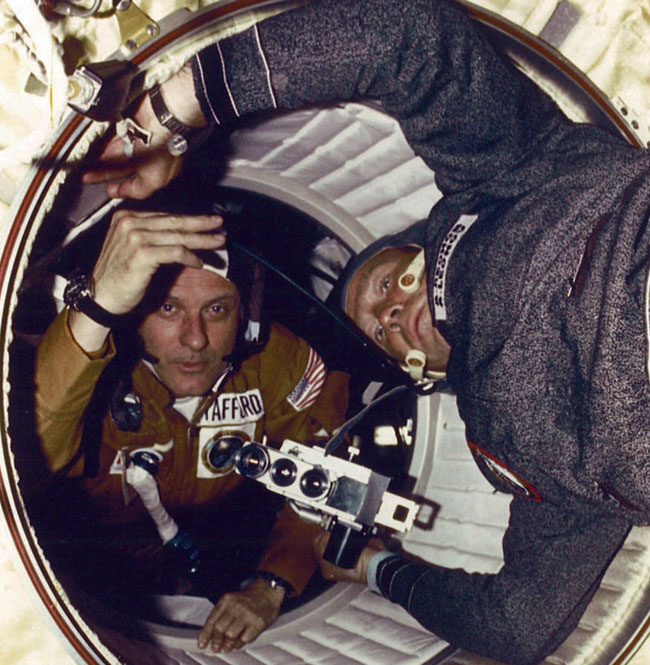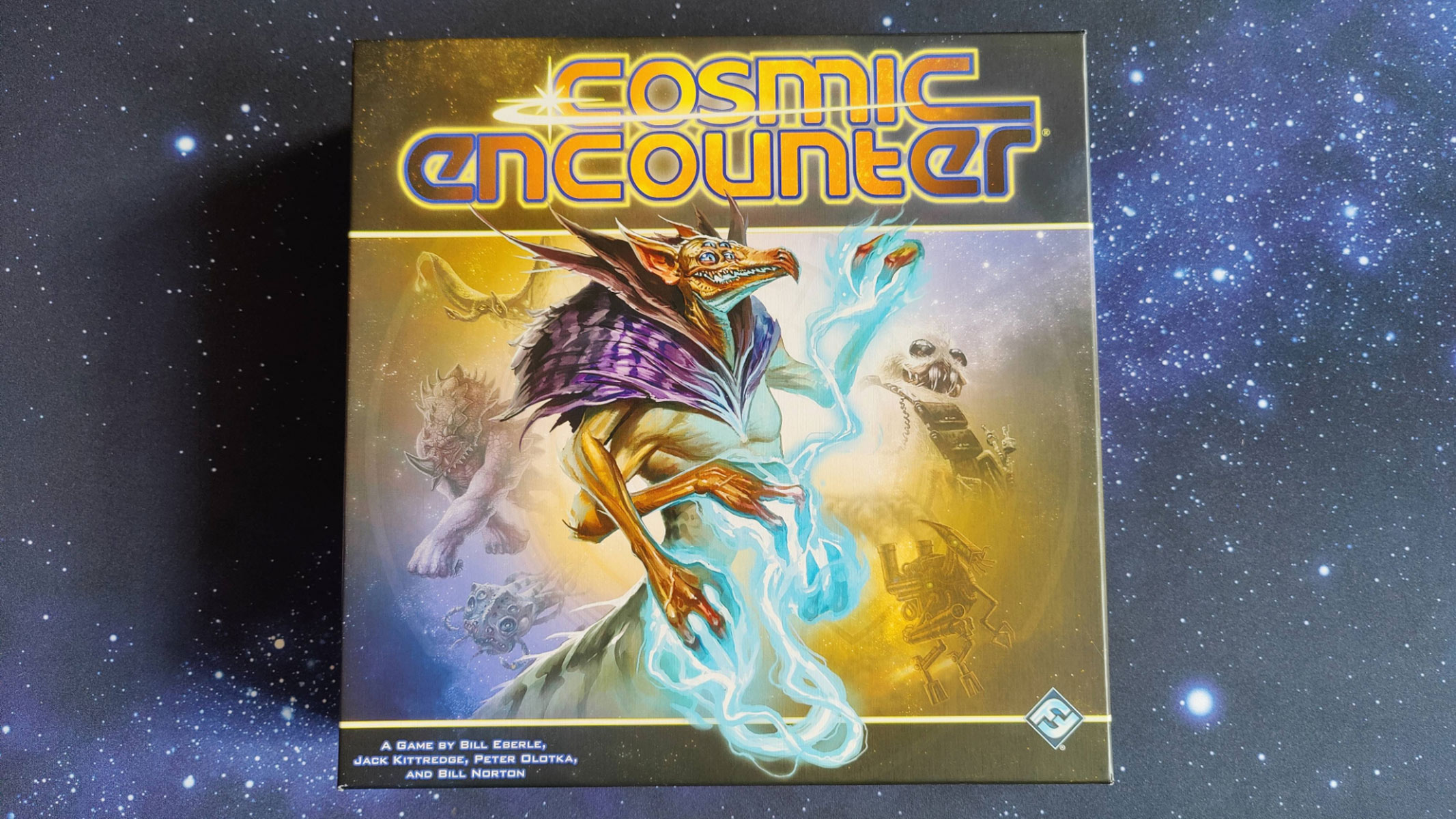First International Space Crew Reunites for Mission's 35th Anniversary

Thefour surviving American astronauts and Soviet-era cosmonauts who flewthe firstinternational space mission, the 1975 Apollo-Soyuz Test Project,reunited onThursday to celebrate the flight's 35th anniversary and introduce acommemorative edition of the watch they wore in space.
ThomasStafford and Vance Brand, who with the late Donald "Deke" Slaytonformed the Apollo-SoyuzTest Project's (ASTP) American crew, met with their Russiancounterparts, AlexeiLeonov and Valery Kubasov at the Omega Watches Boutique in New YorkCity.
Allbut Leonov, who had fallen ill earlier in the day, took part in aneveningpanel discussion at the watchmaker's flagship store coinciding with thedate ofthe mission's two launches.
Twocrews, one mission
Separatedby half a world and 7 1/2 hours, the Soviet Soyuz and U.S. Saturn IBrocketslifted off on July 15, 1975 from the Baikonur Cosmodrome in KazakhstanandKennedy Space Center in Florida, respectively. Two days later, the twocapsulesrendezvoused and connected with the help of a specially-designeddocking adapterthat launched with the U.S. spacecraft.
"Wegot up there and I flew in and we did the docking, and we weresoft-docked andcaptured," recalled Stafford, the U.S. commander for the ASTP mission,inan interview. "I spoke to him in Russian and so did Vance, and ValeryandAlexei spoke to us in English, and then we moved into the hard dock andwe werelocked together. Alexei said, 'We have capture.'"
Threehours after docking, at 3:17 p.m. EDT on July 17, the hatches wereopened andStafford and Leonov greeted each other.
Get the Space.com Newsletter
Breaking space news, the latest updates on rocket launches, skywatching events and more!
"Thebest part of our joint flight was the occasion when we opened the hatchand Isaw the face of Tom Stafford," described Leonov, who in addition toserving as the Soviet commander for the ASTP mission was the first toconduct aspacewalk 10 years earlier. "I said, 'Hello Tom! Hello Deke!' and atthismoment we shook hands."
Upto then, the U.S. and Soviet Union were competitors in a space racethatbegan two decades earlier. The next two days of joint crew operationswere thepinnacle of four years of planning and cooperation between the two ColdWaradversaries. [NASA'smost memorable missions.]
"Itwas shown as a symbol to the rest of the world that two greatsuperpowers withdifferent languages, different units of measurement, and certainlydifferentpolitical systems could have a common goal they could work together toachieve.It was really the highpoint of the opening of the Iron Curtain and agreatgoodwill in the middleof the Cold War," remarked Stafford.
Buildingoff cooperative success
"Apollo-Soyuzstarted a big thing," remarked Brand, who served as Apollo commandmodulepilot. "It has evolved into other cooperative programs: Mir and the InternationalSpace Station (ISS). The International Space Station hassomething like 15countries involved. There is a lot of cooperation that I think wasneverexpected back in the 1970s and it has been a very good thing."
"Thirty-fiveyears later, there are so many areas where we have good cooperation,"Leonov agreed.
Duringtheir two days together in orbit, the astronauts and cosmonautsexchangedceremonial gifts — including U.S., Soviet and United Nations flags,commemorative plaques, medallions, certificates and tree seeds — andconductedjoint science experiments. The three Americans and two Russians visitedeachother's spacecraft, shared meals and conversed in each other'slanguage.
Theyalso spent time observing their respective nations from space.
"Valeryand I had a telecast over the Soviet Union, which was a little bitlarger thanwhat Russia is now. It was a huge country — still is — and to getacross it,it was nine or 10 time zones, at least," described Brand. "I rememberlooking down at that terrain and Valery and I were describing it topeople. Wewere describing the mountains, the deserts, the fields, the cities andthat wasan example of something that was a lot of fun to do."
Lookingback: a historic flight
Thecrew members today see their mission and the way they conductedthemselvesaboard as having provided the groundwork for the internationalspace projects that followed in the three decades since.
"Thebasis, the premise of how we operate [the ISS] was all based onApollo-Soyuz,or Soyuz-Apollo as they say in Russia," said Stafford.
"Ithink that crews now in orbit on the International Space Station usethelessons from the Soyuz-Apollo mission for how to fly in space togetherwithother countries like the United States, Russia and European countries,"added Kubasov, who later flew another international mission with thefirstHungarian in space.
Indeed,the Russian commander of the next Soyuz to fly to the InternationalSpace Stationin October recalled the ASTP mission during an interview earlier thisweek.
"Whenthe Soyuz-Apollo flight happened, I was a student and I could onlydream ofbecoming a cosmonaut at that time. But then I got to know and becameacquaintances with all of the Soviet cosmonauts who participated in theprogram. I became friends with all of them. And of course, I got tomeet TomStafford and Vance Brand — Deke Slayton was not alive by then — andso I gotinterested in the program. It was very exciting," said Alexander Kaleri.
"Atthat time, it was very hard if not impossible to imagine that it wouldall leadup to this," added Kaleri, who on prior missions has worked withinternational crews aboard Mir and the ISS.
"Ithink we are all happy that our mission 35 years ago inspired people tobecomeastronauts back then and they are now flying in space," remarked Brand.
"Afterour flight, the Soviet government said that the flight of Soyuz-Apollowasconducted 'perfectly.' It was the first time [to be called perfect], bytheway," said Leonov.
"Thisprogram was an example of very good cooperation between our scientists,different specialists and the crew. It was very nice to be perfect thefirsttime," he said.
Commemoratingtheir time together
Theastronauts and cosmonauts had a chance to reflect and celebrate theiranniversary together courtesy of Swiss watchmaker Omega, whoseSpeedmasterProfessional chronograph was worn by both the American and Soviet crewmembersduring the mission.
"Thirtyfive years ago, on the Soyuz-Apollo mission we had Omega watches.Russiancosmonauts took these Omega watches for the first time," explainedKubasov.
"TheSoviet crew noticed that all of our crews had Omega [watches] and weexplainedhow they had been through very, very rigorous tests and had been thereforGemini and all through Apollo, Skylab and now we were wearing them forApollo-Soyuz. They were a standard issue to all the Americanastronauts,"said Stafford. "They decided — so that we could be synchronizedtogether— that we would all wear Omegas."
"Afterthat, we flew more Omega watches with Russian crews in space. ButduringSoyuz-Apollo mission, Omega watch helped us to dock our spacecraft inspace andto do our program in space successfully," added Kubasov.
Tocelebrate the mission, Omega has introduced this year alimited-to-1,975-pieces, 35th anniversary Apollo-Soyuz Test ProjectSpeedmasterProfessional. In addition to featuring the mission's insignia etched onitscase back, the watch has a dial crafted from a meteorite.
OnThursday, the two Americans and two Russian crew members signed anddonated 10of the watches to the Omega Boutique in New York.
Asfor their own space-flown Omegas, the U.S. crew's timepieces now belongto theSmithsonian. Leonov flew three Omegas on the mission, one each set to"American time, Moscow time and flight time." Kubasov flew two of thechronographs.
"Itook on this flight two Omega watches, one on my hand [wrist] and onein myspacecraft. After our landing and return on the Earth, I give one ofthe Omegawatches to my son and one I give in Russian space museum. My son usesthatOmega watch even now, after 35 years," said Kubasov.
- NASA'sMost Memorable Space Missions
- Top10 Soviet and Russian Space Missions
- Timeline:50 Years of Spaceflight
Join our Space Forums to keep talking space on the latest missions, night sky and more! And if you have a news tip, correction or comment, let us know at: community@space.com.

Robert Pearlman is a space historian, journalist and the founder and editor of collectSPACE.com, a daily news publication and community devoted to space history with a particular focus on how and where space exploration intersects with pop culture. Pearlman is also a contributing writer for Space.com and co-author of "Space Stations: The Art, Science, and Reality of Working in Space” published by Smithsonian Books in 2018.In 2009, he was inducted into the U.S. Space Camp Hall of Fame in Huntsville, Alabama. In 2021, he was honored by the American Astronautical Society with the Ordway Award for Sustained Excellence in Spaceflight History. In 2023, the National Space Club Florida Committee recognized Pearlman with the Kolcum News and Communications Award for excellence in telling the space story along the Space Coast and throughout the world.
